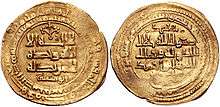Muhammad of Ghazni
| Muhammad | |
|---|---|
 | |
| Sultan of the Ghaznavid Empire | |
| Reign |
1030-1030 1040-1041[1] |
| Predecessor | Mahmud of Ghazni |
| Successor | Mas'ud I of Ghazni |
| Born |
998 Ghazni (now in Afghanistan)[2] |
| Died |
1041 Ghazni |
| Burial | Ghazni |
| Consort | Daughter of Abu'l-Nasr Muhammad |
| House | Ghaznavids |
| Father | Mahmud of Ghazni |
| Religion | Sunni Islam |
Muhammad of Ghazni (Persian: محمد غزنوی) (died 1041) was sultan of the Ghaznavid Empire briefly in 1030, and then later from 1040 to 1041. He ascended the throne upon the death of his father Mahmud in 1030. He was the younger of a set of twins; this circumstance resulted in civil strife.[3] His reign lasted five months before he was overthrown by his twin Ma'sud I, after which he was blinded and imprisoned. Nine years later he was reinstated for a year before being slain by his nephew Maw'dud. According to Ferishta, his reign lasted only 50 days before he was blinded and imprisoned on the order of Ma'sud I. A year later he was murdered by his nephew Maw'dud.[4]
Biography
Mohammed was born along with his elder twin brother Mas'ud in 998 at the Ghaznavid capital of Ghazni. In ca. 1008, Mohammad married the daughter of the Farighunid ruler Abu'l-Nasr Muhammad. Two years later after the death of Abu'l-Nasr Muhammad, Mohammad was appointed by his father as the governor of Guzgan, thus putting an end to the native Farighunid dynasty of Guzgan.
In 1030, Mahmud, because of his bad relations with his heir Mas'ud, changed his opinion, and appointed Mohammad as his heir,[5] who was much more less experienced in government and military affairs than Mas'ud. Mahmud shortly died, and was succeeded by Mohammad, who then appointed Abu Sahl Hamduwi as his vizier. At his accession, much power of the state was under the former vizier Hasanak Mikali and military officer Ali ibn Il-Arslan, who greatly administered the state. Muhammad shortly appointed his uncle Yusuf ibn Sabuktigin as the commander-in-chief of the army. Although Muhammad did not possess any real power, his empire flourished.[6] Soon, however, Muhammad's slave troops (ghulam) railed under Abu'l-Najm Ayaz, who had openly changed his allegiance to Muhammad's brother Mas'ud, whose military campaigns in western Iran had earned him a great reputation.[5] Ayaz was shortly joined by other military officers such as Ali Daya. Muhammad then sent an army under his general Suvendharay to quell the rebellion, but the rebels eventually emerged victorious and killed Suvendharay. The victorious rebels then went to Mas'ud, who was at Nishapur.[6]
Furthermore, Yusuf ibn Sabuktigin and Ali ibn Il-Arslan including the rest Ghaznavid army of also joined Mas'ud.[5] Mas'ud then marched towards Ghazni, where he defeated Muhammad and had him imprisoned, while crowning himself as the new Sultan of the Ghaznavid Empire.
According to Ferishta, Differences between Muhammad and his twin brother Mas'ud became worse by the time. A time came when Muhammad prepared an army to attack Mas'ud. He encamped with his army at the place of "Nakiya-abaad/Nakbat-abaad" for a month. At that place, most of his leaders and army revolted against him. They arrested and imprisoned Muhammad. Moreover, they welcomed Mas'ud as their new leader.[4]
Later, when the Seljuks were overrunning the western parts of the Ghaznavid Empire, a mutiny among the Ghaznavid troops placed Mohammad back upon the throne, and he had his brother Mas'ud imprisoned in turn. He promoted his son Ahmed, allied with Suleiman ibn Yusuf, to the actual day-to-day running of affairs. They are reported to have been behind the assassination of Mas'ud I while he was imprisoned.
Mas'ud I's son Maw'dud, then stationed in Balkh, gathered his forces and marched upon Ghazni, capturing the throne and sentencing Mohammad to death.
See also
References
- ↑ C.E. Bosworth, The New Islamic Dynasties, (Columbia University Press, 1996), 296.
- ↑ Mahmud of Ghazni, The Great Events by Famous Historians: Indexes, Vol. XX, Ed. John Rudd, Charles F. Horne and Rossiter Johnson, (1905), 141.
- ↑ Encyclopædia Iranica, "Ghaznavids", by C. Edmund Bosworth. December 15, 2001. Accessed on July 6, 2012.
- 1 2 Tareekh-e-Firishta, by Mohammad Qasim Firishta, written in 1611 CE, Accessed 2013 CE
- 1 2 3 Bosworth 1975, p. 187.
- 1 2 Bosworth 2011, p. 101.
Sources
- Bosworth, C. E. (1975). "The early Ghaznavids". In Frye, R. N. The Cambridge History of Iran, Volume 4: From the Arab Invasion to the Saljuqs. Cambridge: Cambridge University Press. pp. 162–198. ISBN 0-521-20093-8.
- Bosworth, C. E (1995). The Later Ghaznavids: Splendour and Decay: The Dynasty in Afghanistan and Northern India 1040-1186. Retrieved 9 May 2014.
- Bosworth, C. E. (2011). The Ornament of Histories: A History of the Eastern Islamic Lands AD 650-1041: The Persian Text of Abu Sa'id 'Abd Al-Hayy Gardizi. I.B.Tauris. pp. 1–169. ISBN 978-1-84885-353-9.
- Bosworth, C. Edmund (1985). "ʿALĪ B. IL-ARSLAN QARĪB". Encyclopaedia Iranica, Vol. I, Fasc. 8. London et al.: C. Edmund Bosworth. p. 872.
| Preceded by Mahmud |
Ghaznavid Sultan 1030–1031 |
Succeeded by Mas'ud I |
| Preceded by Mas'ud I |
Ghaznavid Sultan 1040–1041 |
Succeeded by Maw'dud Ghaznavi |